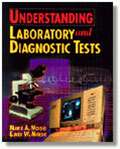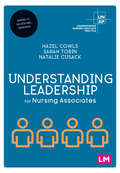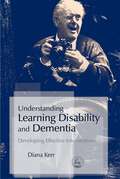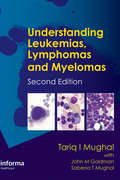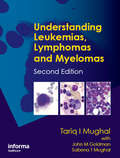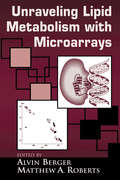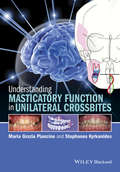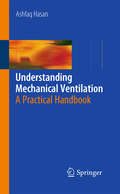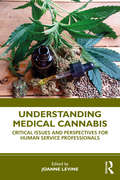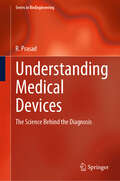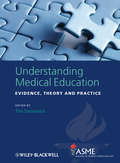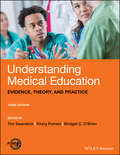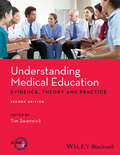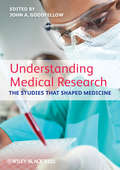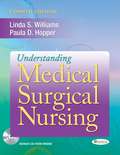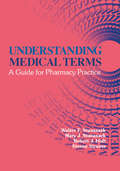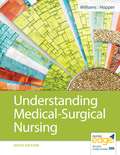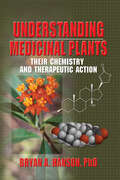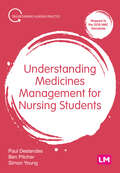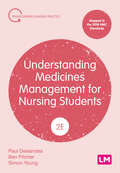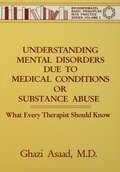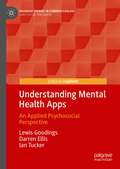- Table View
- List View
Understanding Laboratory and Diagnostic Tests
by Marie A. Moisio Elmer W. MoisioIdeal for instruction in nursing, health information, medical assisting, medical transcription or health unit coordinator programs, this book contains numerous end-of-chapter exercises and case studies to challenge the learner. The most commonly ordered tests are covered, complete with an accurate description of the name and type of test, how the test is performed, indications and contraindications for the test, and most importantly the purpose or diagnostic significance of the test. When appropriate, tests are linked to diagnoses or problems. Many lab books on the market are geared solely for the nurse or technician who must perform the test whereas this book is an excellent resource for any allied health professional who needs a basic understanding of commonly ordered laboratory and diagnostic tests. (health information management,
Understanding Leadership for Nursing Associates (Understanding Nursing Associate Practice)
by Hazel Cowls Sarah Tobin Natalie CusackDemonstrating leadership is entwined with many aspects of the nursing associate role. It is found in your workload management, prioritisation and delegation. It is found in the way you contribute to your team and supervise others. It is found in the way you deliver care and implement quality improvement. In short, understanding leadership is key to your future career. This book offers a first step into the world of leadership. Introducing the theory and principles of leadership you need to know, it shows you how to apply them to your every day role and build confidence in yourself as a leader. Key features - Fully mapped to the NMC Standards of Proficiency for Nursing Associates (2018) - Explains the theory and principles of leadership in clear, straightforward language - Case studies and activities illustrate leadership across a range of scenarios and care settings - Written specifically to address the unique experiences, challenges and requirements of the nursing associate role
Understanding Leadership for Nursing Associates (Understanding Nursing Associate Practice)
by Hazel Cowls Sarah Tobin Natalie CusackDemonstrating leadership is entwined with many aspects of the nursing associate role. It is found in your workload management, prioritisation and delegation. It is found in the way you contribute to your team and supervise others. It is found in the way you deliver care and implement quality improvement. In short, understanding leadership is key to your future career. This book offers a first step into the world of leadership. Introducing the theory and principles of leadership you need to know, it shows you how to apply them to your every day role and build confidence in yourself as a leader. Key features - Fully mapped to the NMC Standards of Proficiency for Nursing Associates (2018) - Explains the theory and principles of leadership in clear, straightforward language - Case studies and activities illustrate leadership across a range of scenarios and care settings - Written specifically to address the unique experiences, challenges and requirements of the nursing associate role
Understanding Learning Disability and Dementia: Developing Effective Interventions
by Diana KerrUnderstanding Learning Disability and Dementia covers all the essential issues in supporting a person with a learning disability when they develop dementia. Like the population at large, people with learning disabilities are living longer, and therefore an increasing number are developing dementia. Service providers, planners, doctors, social workers, carers and direct support staff need to be equipped with relevant knowledge prior to the onset of dementia, so that they can devise appropriate therapeutic interventions and coping strategies, including health and medication management and palliative care. This book will provide essential knowledge for anyone involved in the provision of services, assessment of need and direct care and support for dementia sufferers who also have a learning disability.
Understanding Leukemias, Lymphomas and Myelomas
by John M. Goldman Tariq Mughal Tariq I. Mughal John Goldman Sabena T. Mughal Sabena MughalA brand-new edition of the bestselling guide to hematologic malignancies.An international team of contributors come together to present all clinically relevant aspects of leukemias, lymphomas, and myelomas. Using clear terminology, the book discusses salient features, diagnostic procedures, prognosis, and treatments for these cancers.Following on t
Understanding Leukemias, Lymphomas and Myelomas
by Tariq I. MughalAn international team of contributors come together to present all clinically relevant aspects of leukemias, lymphomas, and myelomas. Using clear terminology, the book discusses salient features, diagnostic procedures, prognosis, and treatments for these cancers.Following on the successful steps of the first edition, this Second Edition covers:various types of leukemias, lymphomas, and myelomas utilizing stem cell transplantation side-effects of various treatments future prospects for leukemia, lymphoma, and myeloma targeted therapies and history of the cancers information and support sources for patients
Understanding Lipid Metabolism with Microarrays and Other Omic Approaches
by Alvin Berger Matthew A. RobertsReviewing current studies and previously unpublished research from leading laboratories around the world, Unravelling Lipid Metabolism With Microarrays demonstrates the use of microarrays and transcriptomic approaches to clarify the biological function of lipids. It provides an extensive overview of statistical approaches to microarray data, as well as discussions on how microarrays can be used to understand the role of lipids in the initiation or prevention of disorders such as cancer, diabetes, and obesity. Of particular note is a chapter by the only group known to study the effect of lipids on transcriptomics in multiple brain regions.
Understanding Masticatory Function in Unilateral Crossbites
by Stephanos Kyrkanides Maria G. PiancinoUnilateral posterior crossbite is a problem often seen in orthodontic practice, and properly understanding chewing patterns will lead to the most effective treatment program. Drawing on their research and available literature, Drs. Piancino and Kyrkanides present a fascinating look at chewing cycles and their role in the functional treatment of unilateral posterior crossbite. Describes the physiology and pathology of chewing patterns and muscular activation in humans Explains chewing patterns and muscular coordination, and their influence on the growth and harmony of the stomatognathic system Clinical instruction for checking and correcting masticatory function and functional asymmetry in order to prevent the relapse of the malocclusion Clinical cases walk readers through the treatment of seven crossbites
Understanding Mechanical Ventilation
by Ashfaq HasanThis book will familiarize not only physicians but also nurses and respiratory therapists with the concepts that underlie mechanical ventilation. A conscious attempt has been made to emphasize medical physiology throughout the book, in order to specifically address the how`s and why`s of mechanical ventilation. At the same time the book incorporates the current strategies for the mechanical ventilation of patients with specific disorders; this should be of some use to the specialists practicing in their respective ICUs.
Understanding Medical Cannabis: Critical Issues and Perspectives for Human Service Professionals
by Joanne LevineThis accessible text provides trainee human service providers and those currently working in the field with a comprehensive, cutting-edge overview of topics related to the medical and therapeutic use of cannabis. Employing an interdisciplinary, biopsychosocial framework, the book explores the different biological, cultural, and policy contexts of medical cannabis from a wide range of perspectives including practitioners, academics, and medical cannabis advocates. This book bridges the gap between theory and practice and underscores the urgent need for expanded and rigorous scientific research as medical cannabis is increasingly legalized, that may result in new cannabis-based medicines and help in identifying what health risks cannabis use may present. Chapters are both evidence-based and practical, weaving in learning objectives, review questions, and varied case examples, all of which will prepare students and professionals for the reality of working with medical cannabis consumers.
Understanding Medical Devices: The Science Behind the Diagnosis (Series in BioEngineering)
by R. PrasadThis book provides an accessible and comprehensive exploration of the principles and mechanisms behind widely used medical diagnostic tools. Written in clear, simple language, it offers a deep understanding of these instruments, their functionality, and the underlying science, making it ideal for a broad audience, including medical professionals, educators, and curious readers. The book begins with foundational concepts such as electromagnetic radiation, analog and digital signals, and binary systems, before diving into detailed discussions of key diagnostic tools like the stethoscope, thermometer, and pulse oximeter. Advanced imaging technologies such as X-rays, CT scans, MRI, and PET scans are thoroughly explained, along with non-invasive tools like ultrasound scanners and glucometers. Each chapter emphasizes the real-world applications and significance of these devices, with simple explanations supported by illustrative examples and figures. Designed for mixed readership, this book provides insights into the science behind diagnostic tools while also fostering a deeper appreciation for their practical impact on healthcare.
Understanding Medical Education
by Tim SwanwickFor the first time in a single core textbook, the Association for the Study of Medical Education presents a complete and authoritative guide to medical education. Written by leading experts in the field, Understanding Medical Education provides a comprehensive resource of the theoretical and academic bases to modern medical education practice.This accessible and timely reference is designed to meet the needs of all those working in medical education from undergraduate education through postgraduate training to continuing professional development. As well as providing practical guidance for clinicians, teachers and researchers, Understanding Medical Education will prove an invaluable resource to those studying at certificate, diploma or masters level and a first 'port-of-call' for anyone engaged in medical education as an academic discipline.Exploring medical education in all its diversity and containing all you need in one place, Understanding Medical Education is the ideal reference not only for medical educators, but for anyone involved in the development of healthcare professionals, in whatever discipline wherever they are in the world.An on-line edition of the complete book, together with individual chapter downloads, are available at www.wileymedicaleducation.comUnderstanding Medical Education has been brought together and edited by Professor Tim Swanwick, Director of Professional Development in the London Deanery, Visiting Fellow at the Institute of Education and Visiting Professor of Medical Education at the University of Bedfordshire.
Understanding Medical Education: Evidence, Theory, and Practice
by Tim Swanwick Kirsty Forrest Bridget C. O’BrienCreated in partnership with the Association for the Study of Medical Education (ASME), this completely revised and updated new edition of Understanding Medical Education synthesizes the latest knowledge, evidence and best practice across the continuum of medical education. Written and edited by an international team, this latest edition continues to cover a wide range of subject matter within five broad areas – Foundations, Teaching and Learning, Assessment and Selection, Research and Evaluation, and Faculty and Learners – as well as featuring a wealth of new material, including new chapters on the science of learning, knowledge synthesis, and learner support and well-being. The third edition of Understanding Medical Education: Provides a comprehensive and authoritative resource summarizing the theoretical and academic bases to modern medical education practice Meets the needs of all newcomers to medical education whether undergraduate or postgraduate, including those studying at certificate, diploma or masters level Offers a global perspective on medical education from leading experts from across the world Providing practical guidance and exploring medical education in all its diversity, Understanding Medical Education continues to be an essential resource for both established educators and all those new to the field.
Understanding Medical Education: Evidence,Theory and Practice
by Tim SwanwickIn this new and extensively updated second edition, the Association for the Study of Medical Education presents a complete and authoritative guide to medical education. Written by leading experts in the field, Understanding Medical Education provides a comprehensive resource of the theoretical and academic bases to modern medical education practice. This authoritative and accessible reference is designed to meet the needs of all those working in medical education from undergraduate education through postgraduate training to continuing professional development. As well as providing practical guidance for clinicians, teachers and researchers, Understanding Medical Education will prove an invaluable resource to those studying at certificate, diploma or masters level and a first 'port-of-call' for anyone engaged in medical education as an academic discipline. Exploring medical education in all its diversity and containing all you need in one place, Understanding Medical Education is the ideal reference not only for medical educators, but for anyone involved in the development of healthcare professionals, in whatever discipline wherever they are in the world.
Understanding Medical Research: The Studies That Shaped Medicine
by John A. Goodfellow Liam DonaldsonMedical students and junior and senior doctors are frequently called upon to give research presentations, write reports, and answer exam questions on specific areas of medical research. Understanding Medical Research: The Studies That Shaped Medicine is an exciting new title that offers a unique and valuable approach to understanding historically influential studies in important areas of medicine. Featuring chapters from Sir Liam Donaldson and Sir David Weatherall, amongst others, world leading researchers identify ten primary research papers that have shaped the direction of research in their given topic, examining why they were carried out, key findings, and how they changed the field. Each chapter also contains short sections on ‘Key Questions Remaining’ which outline outstanding areas where further research is needed, and a link to ‘Key Laboratories/Clinics’ which point the reader to major research groups of international standing. Covering the seminal research in core areas of medicine, Understanding Medical Research provides an authoritative framework on each topic for medical students and healthcare professionals.
Understanding Medical Surgical Nursing (4th Edition)
by Linda S. Williams Paula D. HopperThe 4th Edition of this groundbreaking textbook continues to teach the "why" of medical-surgical nursing more effectively than any other resource in the field. It presents complex issues in a clear and easy-to-understand manner that encourages students to think critically while applying theory to clinical practice.
Understanding Medical Terms: A Guide for Pharmacy Practice, Second Edition (Pharmacy Education Ser.)
by Robert J. Holt Mary J. Stanaszek Walter F. StanaszekPREFACE TO THE SECOND EDITIONThe need for a thorough understanding of medical terminology has not diminished in the least for pharmacists and other health care practitioners in the five years between the publication of the first edition of this book and this second edition. If anything, it has become greater. The pharmacy profession has further solidified its clinical role in patient care, and pharmacists are more entrenched than ever before in the role of counselor and advisor to both patients and practitioners alike. For more than a few pharmacists, what not long ago was an occasional question from a physician about appropriate drug therapy has become regular consultation concerning the interaction of drugs with the patient, his life, and the many other therapies he may be facing. Pharmacy chains, which not long ago installed glass walls to separate the pharmacist from customers, have asked technicians to count pills while pharmacists are in continuous contact with the patient. Such practice changes have increased the demand for clinical knowledge among pharmacists, including a knowledge of medical terminology, and those demands have been passed on to the authors in preparation of the second edition of this book. While the role of the text is still to help pharmacists be more effective interpreters and counselors, some changes have been made in response to reader requests.
Understanding Medical-Surgical Nursing
by Linda Williams Paula HopperEasy-to-read Nursing Care Plans feature the rationale for each action. Critical-thinking case studies and critical-thinking questions promote the transition from theory to practice. Geriatric content throughout familiarizes students with this important patient demographic. Learning tips promote understanding and retention of the material. End-of-chapter review questions with answers prepare students for chapter tests and for the NCLEX-PN. (Rationales are provided in the Student Resources on Davis Edge.) Nearly 2,000 NCLEX-style questions that align to Understanding Medical-Surgical Nursing with page references. Pre-set assignments that correlate directly to textbook content and the Davis's Nursing Skills Videos for LPN/LVN. Comprehensive rationales for both correct and incorrect answers to promote in-depth understanding. Test-taking tips to prepare students for exams and build their confidence. All different question types, including those that students struggle with like alternate format, select all that apply (SATA), prioritization and ordered response. Responsive design for access from laptop, tablet, and mobile devices.
Understanding Medicinal Plants: Their Chemistry and Therapeutic Action
by Bryan HansonLearn how medicinal plants work from the chemical level upwardUnderstanding Medicinal Plants: Their Chemistry and Therapeutic Action is designed to teach the chemical concepts necessary to understand the actions of medicinal plants to people who are intimidated by chemistry. This beautifully illustrated, accessibly written guide explores the molecules of medicinal plants and the pharmacology behind their actions on the human body. The book will be valuable to non-science majors, biology majors, interested scientists of different disciplines, and practitioners and students of herbalism and complementary medicine.Understanding Medicinal Plants covers the essentials, including: understanding the symbolism of chemical structure bonding-and predicting useful properties important plant compounds isolation and purification of plant molecules drug delivery and action in the human body the chemistry of antioxidants identification of plant molecules Interest in alternative medicine and herbal products has never been higher than it is now. Understanding Medicinal Plants aims for the middle ground between technical manuals for highly trained individuals and books for the general public that may oversimplify the material. This introductory work provides you with a wealth of suggested reading materials, tables, figures, and illustrations. Three case studies illustrate specific plant drugs and their molecular constituents. This resource also provides an extensive glossary for easy reference. In Understanding Medicinal Plants, you will find a lexicon of medicinally important chemical families found in plants to help you identify and understand the role of constituents such as: alkaloids flavonoids coumarins glycosides amino acids lignans tannins and many moreUnderstanding Medicinal Plants enriches your knowledge of the science behind herbalism and increases your savvy as a consumer of herbal products. This sourcebook will help you better understand the debates about the regulation of medicinal plants and related health care policy debates. With this book, you will be able to interpret media hype about medicinal plants with greater confidence.
Understanding Medicines Management for Nursing Students (Transforming Nursing Practice Series)
by Simon Young Ben Pitcher Paul DeslandesUnderstanding medicines management is central to the nursing role. As a nurse, you will need to make informed decisions about medicine use and optimisation, tailored to each patient. This book equips you with the theoretical and practical foundation to do just that. It covers all key components of medicines management, using a scenario-based approach to illustrate how each topic relates to your practice. Key features · Fully mapped to the NMC standards of proficiency for registered nurses (2018) · Scenarios and activities help you to translate the theory into nursing practice · Acts as a stepping stone to support your readiness to undertake a prescribing qualification upon registration
Understanding Medicines Management for Nursing Students (Transforming Nursing Practice Series)
by Simon Young Ben Pitcher Paul DeslandesUnderstanding medicines management is central to the nursing role. As a nurse, you will need to make informed decisions about medicine use and optimisation, tailored to each patient. This book equips you with the theoretical and practical foundation to do just that. It covers all key components of medicines management, using a scenario-based approach to illustrate how each topic relates to your practice. Key features · Fully mapped to the NMC standards of proficiency for registered nurses (2018) · Scenarios and activities help you to translate the theory into nursing practice · Acts as a stepping stone to support your readiness to undertake a prescribing qualification upon registration
Understanding Medicines Management for Nursing Students (Transforming Nursing Practice Series)
by Paul Deslandes Ben Pitcher Simon YoungUnderstanding medicines management is central to the nursing role. As a nurse, you will need to make informed decisions about medicine use and optimisation that′s tailored to each patient in your care. This book equips you with the theoretical and practical foundations to do just that. It covers the key components of medicines management for all fields, using a scenario-based approach to illustrate how each topic relates to your real-life practice . Key features · Fully mapped to the NMC standards of proficiency for registered nurses (2018) · Scenarios and activities help you to translate the theory into evidence-based practice, from injections and dosing to safety and ethics. · Now with new discussions on medicines adherence, access to medicines, cultural competence and treating children. · Acts as a stepping stone to support your readiness to undertake a prescribing qualification upon registration
Understanding Medicines Management for Nursing Students (Transforming Nursing Practice Series)
by Paul Deslandes Ben Pitcher Simon YoungUnderstanding medicines management is central to the nursing role. As a nurse, you will need to make informed decisions about medicine use and optimisation that′s tailored to each patient in your care. This book equips you with the theoretical and practical foundations to do just that. It covers the key components of medicines management for all fields, using a scenario-based approach to illustrate how each topic relates to your real-life practice . Key features · Fully mapped to the NMC standards of proficiency for registered nurses (2018) · Scenarios and activities help you to translate the theory into evidence-based practice, from injections and dosing to safety and ethics. · Now with new discussions on medicines adherence, access to medicines, cultural competence and treating children. · Acts as a stepping stone to support your readiness to undertake a prescribing qualification upon registration
Understanding Mental Disorders Due To Medical Conditions Or Substance Abuse: What Every Therapist Should Know
by Ghazi AsaadThis text is a unique handbook that will heighten the awareness of all mental health professionals and students toward organic factors in mental illness.
Understanding Mental Health Apps: An Applied Psychosocial Perspective (Palgrave Studies in Cyberpsychology)
by Darren Ellis Ian Tucker Lewis GoodingsThis is the first book to look exclusively from at the use of MHapps from an applied psychosocial perspective. Much of the academic literature on MHapps in psychology focuses on the clinical efficacy of using apps (e.g., depression reduction as result of using a certain app) and will typically report on the use of randomised controlled trials (or a similar method) to illustrate the use of apps as a tool for improving a psychological condition. Therefore, the main benefit of this book is that it recognises the impact of apps from a social perspective and will aim to show how everyday forms of distress are embedded in the use of these apps and the broader set of relations that constitute people’s everyday lives. The content of this book will identify how an applied social perspective can offer insight into the power of apps to shape our sense of ourselves and of others. This book will be of use to educators and students in psychology, sociology, health studies, media studies andcultural studies.
